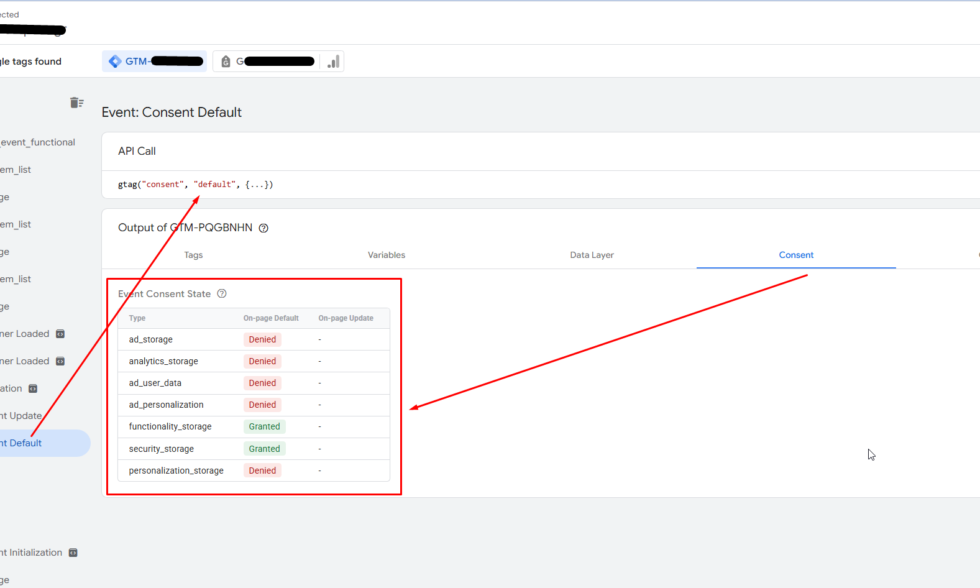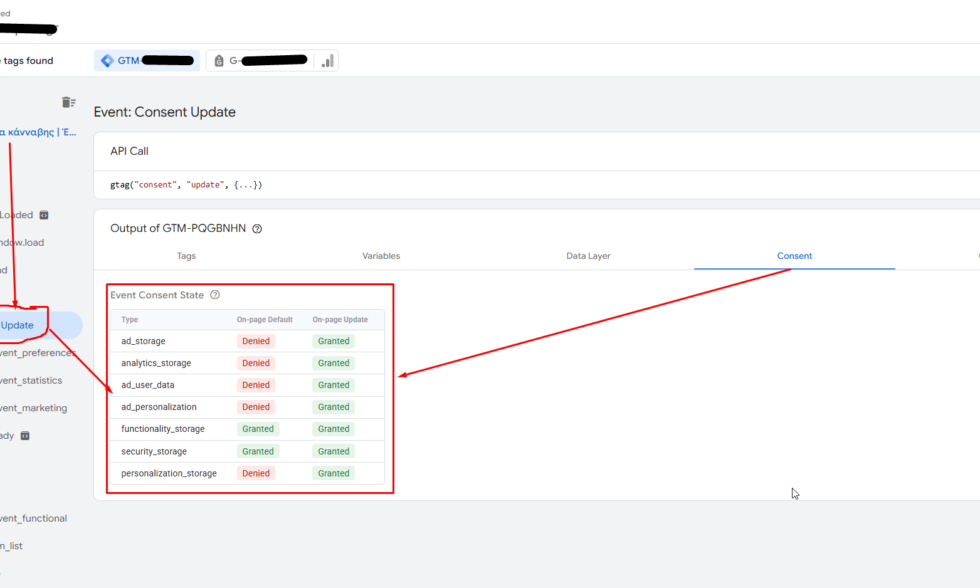No products in the cart.
Google Consent Mode V2 – Advance Mode Setup
Here, I have attached the Successful Past Projects’ Results of my previous clients for Google Consent Mode V2 advanced implementation.
✅ Services Included in This Setup:
We don’t just install tags—we solve problems and maximize accuracy. Here are the core features delivered in our advanced Consent Mode V2 setup:
- ✔ Google Consent Mode V2 advanced configuration
- ✔ Integration with Consent Management Platforms (CookieBot, OneTrust, Quantcast, Complianz, etc.)
- ✔ Setup for all four consent signals: ad_storage, analytics_storage, ad_user_data, ad_personalization
- ✔ GTM Consent Initialization trigger setup with default-denied state
- ✔ CMP-to-GTM mapping for consent updates
- ✔ Tag adjustments for GA4 and Google Ads to respect user consent
- ✔ Server‑Side tagging compatibility
- ✔ Full support for Shopify, WooCommerce, Magento, Wix, BigCommerce, Custom CMS platforms
🛠️ Testing via GTM Tag Assistant & Network Tab to confirm correct implementation
🛠️ Fixes for Common Consent Mode V2 Tracking Issues
We often resolve:
- ❌ Google Ads remarketing/audience lists broken in EU/EEA
- ❌ GA4 audiences lost due to consent restrictions
- ❌ Consent Mode not triggering properly on user choices
- ❌ No adaptation to iOS/browser privacy and DM Act requirements
- ❌ Incomplete or misconfigured ad_user_data or personalization signals
💡 We’ve implemented compliant and data-resilient Consent Mode V2 setups hundreds of times—precisely and permanently.
🎯 Capturing Rich Compliance + Marketing Data
We ensure optimal balance of privacy and performance:
- Preserve GA4 audiences and Google Ads remarketing even on cookie decline
- Enable conversion modeling to backfill data gaps
- Maintain ad personalization where permitted
- Ensure uninterrupted ad delivery, bidding, and measurement under user privacy settings
🚀 Why This Consent Mode V2 Setup Works
- Compliant & Conversion-Sensitive – aligns with GDPR, ePrivacy, and DMA regulations
- Advanced Tag Activation – cookieless pings maintain modeling even without consent
- Future-Proof Tracking – resilient to regulatory updates and browser privacy changes
- Performance Safe – protects remarketing and audience capabilities while respecting privacy
👨💻 Why Clients Choose Incisive Ranking
At Incisive Ranking, we’re not just implementation experts—we’re privacy-strategy specialists. With over 8 years of experience and 2,500+ projects completed, we specialize in:
- 🏷️ Consent Mode V2 advanced deployment
- 📊 Google Tag Manager & Server‑Side Tagging
- 🛒 eCommerce & Conversion Tracking
- 🔄 Server‑Side Integrations for GA4, Google Ads, Meta, TikTok, Pinterest, etc.
- 🎥 Testing tools (Tag Assistant, network debugging)
- 🛠️ Ongoing compliance support and performance monitoring
✅ Ready to Secure Compliance & Performance?
Book a Free 30‑minute Tracking Transformation Call and balance user privacy with robust ad and analytics performance—using Consent Mode V2 Advanced.
What will you get?
I will implement a cookie consent management platform (CMP) of your choice using GTM to your website
I will ensure to adjust how your tracking tags behave based on the consent status of your user
I will implement Google Consent Mode V2 Advance to your Google tags (GA4 and Google Ads) that recover up to 70% of ad-click-to-conversion journeys lost due to user cookie consent choices
Cookie Consent Platforms I’ve Worked On
CookieBot
Usercentrics
Quantcast Choice
OneTrust
CookieYes
It’s okay if you use different CMP tool or another CMS.
What are the main features of Google Consent Mode V2?
Google Consent Mode V2 includes numerous critical features that represent a significant shift in how user data is handled inside the Google ecosystem, notably in the European Economic Era (EEA):
- Granular User Control: This is the foundation of Consent Mode Version 2. Users are no longer limited to a binary “all or nothing” decision about their data. Instead, they may specify which data types they want to exchange and for what purposes, providing a considerably more granular degree of control.
- Standardized Language (TCF v2.0): Consent options are translated into a standardized format known as TCF v2.0, which ensures clear communication between users, websites, and Google. This eliminates uncertainty and guarantees that everyone knows the user’s data preferences.
- Flexible Adaptation: Google tags and SDKs, the tools used by websites and apps to collect and manage data, adjust their behavior based on user agreement. For example, if a user declines ad user data consent, tailored advertising will not appear. This flexibility enables firms to adjust their data practices to particular user preferences.
- Data Gap Modeling: Even with restricted permission, Google may employ sophisticated algorithms to model and fill data gaps for conversion monitoring. This allows firms to maintain some level of ad effectiveness while respecting users’ privacy preferences.
- Transparency and Trust: Consent Mode V2, by offering people more control over their data, promotes transparency and trust between users and businesses. This can result in stronger relationships and a better user experience.
- Compliance with GDPR and other Privacy requirements: Consent Mode V2 helps websites comply with GDPR and other privacy requirements, lowering the risk of legal and reputational damage for EEA firms.
- Beyond customized Ads: While customized ads may be limited by some consent options, Consent Mode V2 allows firms to experiment with alternative targeting tactics such as contextual advertising, demographics-based targeting, and first-party data capture. This opens the door to new and imaginative ways to reach specific audiences while protecting user privacy.
- Ongoing Dialogue: Consent is not a one-time setting. Users can adjust their preferences at any moment by providing new signals to Google, and the system will adapt accordingly. This guarantees that user control is both dynamic and relevant.
- Technical Challenges: Implementing Consent Mode V2 necessitates technical skills, since firms must integrate with Consent Management Platforms (CMPs) and modify their website practices. This can be difficult for some businesses, but resources and help are available.
Overall, the primary features of Google Consent Mode V2 are an important step toward a more user-centric and privacy-conscious data environment. Consent Mode V2, by giving users control over their data, increasing openness, and encouraging unique ways to collect and target data, lays the path for a future in which businesses may succeed while respecting user privacy.
Let’s Audit First, Why is it Required?
Tracking errors can greatly affect your Data, Conversion Reporting, strategic Decision-Making and that Cost you in Revenue.
First, I audit your website’s current Tag & Tracking configuration. Then I will share errors/recommendations with their solutions as the best practices the industry follows. I can also help you to implement it the right way.







